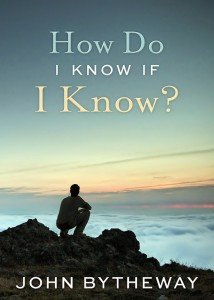Title: How Do I Know If I Know?
Author: John Bytheway
Publisher: Deseret Book
Genre: Devotional
Year: 2014
Binding: Softcover
Number of pages: 138
ISBN: 9781609079215
Cost: $9.99
Reviewed by Ivan Wolfe for the Association for Mormon Letters
John Bytheway has made a fairly nice niche for himself writing books aimed at Mormon youth that do quite a few things well: He doesn’t talk down to them, he avoids overly complicated language, and he presents the ideas straightforwardly.
I could see a complaint that his writing is too simplistic in handling controversial aspects of the gospel (his work is not at all like Adam Miller’s recent “Letters to a Young Mormon” which does tackle hard issues). However, such a criticism would be missing the point. Bytheway aims his work at as wide a cross-section of Mormon youth as possible, and so his aim really is for the “milk” level rather than the “meat” level (to use a common gospel analogy) – and that’s fine. A lot of youth will find value in his work – he basically provides a strong baseline/foundation for them to grow from. Readers can move on from his work to more complicated issues; in fact, that idea is heavily implied in this most recent work.
In “How Do I Know If I Know” Bytheway tackles the somewhat complicated issue of testimony and whether it’s appropriate to ever say “I know” rather than “I believe.” He tackles issues of doubt, which he treats as necessary and part of the continuum of belief (rather than as something to avoid).
The book starts out with an anecdote about Heber J. Grant during a time before he was prophet (or even a general authority). When expressing some doubt about the strength of his testimony, he was told that his problem was he didn’t know that he knew. Bytheway uses that to argue that most youth “know” more than they may think they know. He creates a continuum that goes from “I don’t believe” to “I doubt” and passing a few more intermediate steps to end on “I believe” and then “I know.”
The main chapters focus on different ways for youth to figure out where you are on the scale (and he makes it clear it’s okay if you’re on the lower end – while he clearly wants readers to move up to the higher end, he’s more interested in helping youth figure out where they really are on the scale, rather than where they might think they are). The different “wires” (his overall analogy has to do with the brightness of a light and the electrical system it’s connected to) are “Feelings” (what kinds of feelings do you experience at church, etc.?), “Experiences” (what happens to you as you live the Gospel?), “Evidences” (this chapter summarizes a lot of apologetic research), and “Logic” (by which he really means “your own powers of reason” instead of formal logic – he talks a lot about “what makes sense”).
One interesting aspect of the book is the constant appearance of Q codes (codes for smartphones to link to online content) that link to various LDS videos and other content online (for the smartphone deficient, the full web addresses are also included in the text). This is a nice nod to the technological world the target audience lives in. It’s still a physical book, but an e-book version also exists (I checked on this).
I imagine most often, this book will be given as a gift by parents or leaders to youth who might struggle with their testimonies. Since this book lets them know the struggling is okay and gives practical tools for figuring out how to make it through the struggle, I imagine Bytheway’s most recent book will have a positive impact. It probably won’t help or please anyone already out or almost out of the church, but for those youth who at least desire to know if they know (or believe) anything at all, this could help them out.